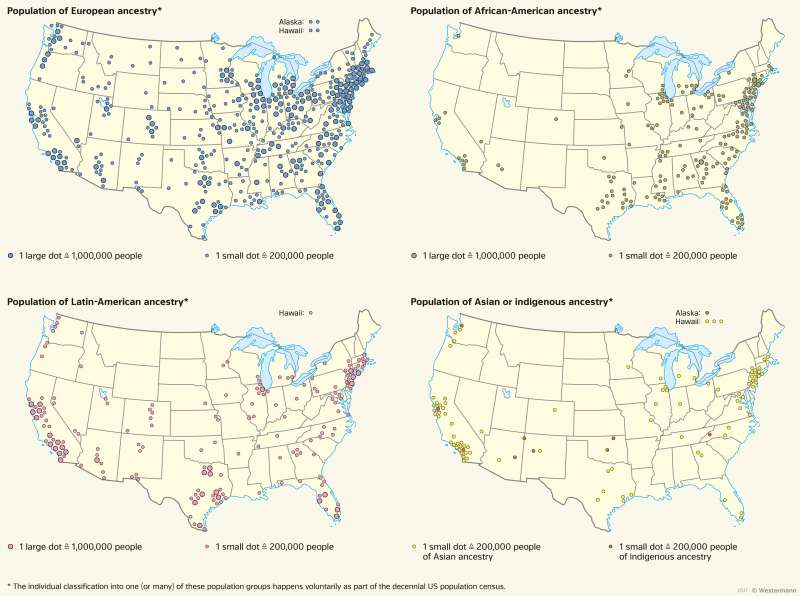United States of America (USA) - Population groups according to ancestry
Immigration shaping the political landscape
978-3-14-100890-6 | Page 171 | Ill. 4

Overview
The population of the USA has become increasingly heterogeneous over the decades, yet historical patterns of immigration can still be discerned today in the spatial distribution of different population groups.
Population of European descent
The descendants of European immigrants still constitute the largest population group today and have settled the entire territory of the USA. In large parts of the country in the north and west, they make up at least 60 per cent of the population, in some places considerably more. Only in the southern parts of the country and in some insular central parts, their share is below 50 per cent due to the increase in other immigrant groups.
Population of Latin American descent
Immigrants of Latin American origin, a very large proportion of whom are Mexican, concentrate in the southwest, along the border with Mexico. They also make up significant proportions of the population in northern New Mexico, parts of Colorado, Nevada, Idaho and Washington, and Florida, while they are scarcely represented in the Northwest as a whole. Their share in the US population has increased considerably over the last five decades. A considerable percentage of Hispanics arrive as illegal immigrants.
Population of Asian or Native American descent
Asians are the most urban-oriented of all population groups. They are mainly found in the large metropolitan areas of the USA. An exception is California, where Asians have comparatively high proportions in all parts of the state. The spatial distribution of the indigenous population still reveals the location of reservations, where about half of the Native Americans live. Cities with larger indigenous minorities include Los Angeles, San Francisco, and Seattle.
Population of African American descent
Most of the African American population descended from slaves who were brought to America to work on the cotton, tobacco, and rice plantations in the southern states. Until the early 20th century, this population group was concentrated in the states in the southeast between Virginia and Louisiana. Only then, an increased migration to the industrial cities of the north occurred, which created entire neighbourhoods dominated by African Americans. Since about 1990, this trend has reversed, in favour of increased concentration in the Southern states. Nevertheless, African Americans still make up an above-average proportion of the population in many old industrial cities. In Detroit, for example, it is over 80 per cent.
Population of Asian or Native American descent
Asians are the most urban-oriented of all population groups. They are mainly found in the large metropolitan areas of the USA. An exception is California, where Asians have comparatively high proportions in all parts of the state. The spatial distribution of the indigenous population still reveals the location of reservations, where about half of the Native Americans live. Cities with larger indigenous minorities include Los Angeles, San Francisco, and Seattle.




